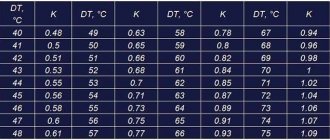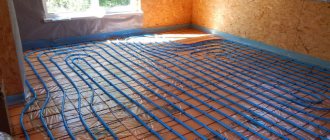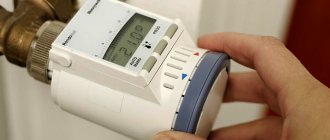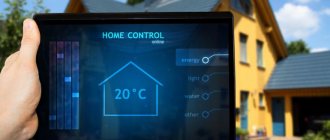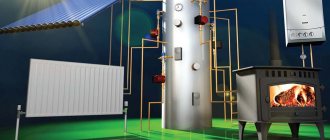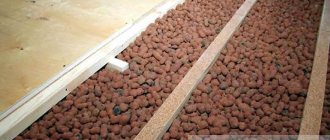Recently, heating systems based on electric convectors have become widespread for heating houses, especially where there is no possibility of connecting mains gas or such connection is very expensive. Compared to heating using the “boiler - water radiators” scheme, heating with electric convectors has undeniable advantages. It is environmentally friendly, it does not require premises for a boiler room or fuel storage, it is easy to install, has low inertia, is reliable and predictable, does not require maintenance, and is much cheaper in terms of equipment and installation costs. The widespread use of heating with electric convectors is hampered by stereotypes that convectors are exclusively auxiliary heaters in addition to the main heating, that they are suitable only for small houses with an area of 80-100 sq.m., that they have the highest energy consumption compared to other types of electric heating, in in particular, compared to heating with an electric boiler.
The electric convector is no longer an auxiliary heater Source home-comfort.ru
Unlike inexpensive convectors with a minimal set of functions, modern convectors are practically different heating devices, the task of which is not just to heat, but to heat wisely. Therefore, on their basis it is possible to install a full-fledged heating system.
Let’s define the terminology of what is considered a full-fledged permanent heating system, and what is simply heating. A complete heating system is:
- possibility of autonomous safe operation for a long time without human presence;
- ease of management, both individual elements of the system and the entire system as a single device, including remotely;
- energy efficiency is a set of devices and technologies that optimize the operation of the heating system to reduce energy consumption while maintaining comfort.
Let's consider the options for using electric convectors and evaluate them according to these criteria.
Heating by convectors with mechanical thermostats
The simplest heating, often used in summer cottages, is inexpensive convectors with a mechanical thermostat. The main capabilities of such convectors are adjusting the temperature with a knob or slider, choosing the operating power - full or half of the nominal value.
This type of convector is suitable for short-term or additional heating to the main heating and cannot be considered as full-fledged for year-round use. Such electric heaters do not use energy-saving technologies, their task is simply to heat, it is risky to leave them unattended (if the heater is an open filament), they operate with large errors of several degrees, each convector must be adjusted separately, and there is no possibility of control via the Internet. The use of GSM or WiFi sockets does not fundamentally change anything, except for the ability to remotely turn on and off an electrical appliance. Installing a room mechanical thermostat that controls several convectors will allow you to set the temperature from one device, but this is the only advantage of such a connection of convectors.
Scheme with a mechanical room thermostat Source home-comfort.ru
Heating by convectors with electronic thermostat
If there are several convectors and they are used for a long time, then simply heating is no longer enough. The first step towards energy efficiency is the ability to program temperature settings for weekdays, weekends, nights and daytime hours so that we can work economically when and where we need it in our weekly schedule. To do this, we will replace mechanical thermostats with electronic ones. An electronic thermostat is a thermostat, but with more precise adjustment of the on/off temperature, plus “brains” that allow you to configure the weekly cycle schedule and the main operating modes (comfortable, economical, minimal). Therefore, it is more correct to call an electronic thermostat a control unit.
Heating with convectors controlled via the Internet
We will continue to modernize the system. If the house is not permanently inhabited, then there is a need for remote monitoring and control of convectors via a mobile application. The mobile application is actually an extended heating system control console. In it you can add/remove heating devices, create separate zones, assign convectors to these zones, managing the zone as a separate device, set parameters for temperature conditions and the operating schedule of each device or zone. As a rule, a mobile application, in addition to controlling convectors, has the ability to control other climate control and household appliances - water heaters, ventilation, air conditioning, lighting, etc., becoming the control center of a smart home.
For such intelligent control, convectors must be connected to the Internet.
There are two most common solutions:
1. System based on inverter convectors. Each convector is equipped with an inverter control unit marked digital Inverter. Electrolux convectors of the Transformer System series with replaceable control units are suitable for this. The inverter control unit has all the same functions as the electronic unit, plus two key differences: the presence of a USB connector for installing a WiFi module for wireless communication with a WiFi router and a fundamentally different operating algorithm of the heating element - with automatic change of heating power.
Which heater is best for a summer house?
Every summer resident knows how important it is to quickly warm up a country house used for seasonal living or weekend relaxation. This is especially true in the spring, with the onset of summer frosts and with the approach of autumn cold weather. Sometimes it is convenient to use electric heaters for this purpose. You just need to make sure that the heater power matches the characteristics of your electrical network. It is the state of the electrical network that sometimes causes difficulties in organizing heating using electrical appliances.
In domestic conditions in the country, the following types of heaters are most often used:
- convector;
- infrared;
- oil
A separate class of heating devices called heat guns is not discussed in this article. They produce increased noise and are not intended for use in domestic environments. Weak fan heaters do not have such disadvantages, but have low power, which does not allow them to effectively warm up the premises of a country house.
Convector heaters
Electrical devices of this type have a heating element that heats up to a high temperature, which gives off heat to air flows rising along its walls. When such a device operates, a fairly intense circulation of air masses occurs, which leads to rapid heating of the room.
Operating principle of a convector heater
The required heater power is selected based on a simple formula: 1 kW for every 10 m2 of area of the heated room. The lineup of any well-known brand is usually represented by products of very different performance. The system of settings and regulation allows you to adapt the operation of the heater to specific conditions.
Manufacturers offer convector heaters of various shapes and sizes. There are options for floor or wall installation. Modern models are equipped with automatic means that can maintain the temperature with an accuracy of a degree, provide a comfortable or economical operating mode, and turn on and off in accordance with a given program at a time specified by the user.
The safe operation of convector heaters is ensured by a special housing design that protects electrical equipment from water ingress, protection against overheating and blocking when tipping over.
+ Advantages of convector heaters
- High rate of room heating.
- Economical operation.
- Fire safety.
- No noise or emission of harmful substances.
- Easy installation and intuitive controls.
- The presence of several operating modes with precise maintenance of the set air temperature provided for a number of models.
- Possibility of not only permanent installation, but also movement around the house.
- There is no need for maintenance, just periodically wipe the dust from the outer surface of the case.
— Disadvantages of convector heaters
- Increased requirements for the reliability of electrical wiring.
- High tariffs for electricity consumption.
Features of application for a summer residence. When choosing convectors for a country house, you must take into account that one convector is designed to heat one room. If you need to heat several rooms, you will have to purchase a convector for each. For ease of use, convectors located in different rooms can be combined into one system with one control unit. This allows you to quickly and accurately regulate the temperature throughout your entire home.
Infrared heaters
This type of heating devices is based on the generation of heat rays. They are absolutely safe and are capable of heating surfaces at some distance from the source. In a similar way, the sun gives us its energy. In the area of operation of such a heater, a person feels as comfortable as possible.
The operating principle of an infrared heater
Infrared heaters can be attached to walls and ceilings. They are most effective when it is not necessary to heat the entire room, but only a certain area of it. They usually have an increased class of protection against moisture, which allows them to be used even in open areas, in showers and bathrooms. Most models of this type are designed for permanent installation. For the convenience of users, manufacturers often provide rotating devices that allow the heating area to be shifted.
+ Advantages of infrared heaters
- Long service life ensured by high reliability of the design and materials used.
- Fire safety.
- Possibility of use outside buildings and in rooms with high humidity.
- Ease of connection and setup.
- Possibility of centralized control of several devices.
- Complete replacement of heated floors.
- Maximum efficiency with spot and zone heating.
— Disadvantages of infrared heaters
- Only permanent installation is provided.
- There are restrictions on minimum and maximum ceiling heights.
- Low degree of control intelligence.
- There is a risk of overheating during prolonged use.
Features of application for a summer residence. All infrared heaters differ in the areas of infrared radiation.
Based on the impact on humans, the following areas of infrared radiation (IR-Infrared Radiation) are distinguished:
- Near (IR-A). Wavelengths from 0.76 to 1.5 microns, penetrate deeply under the skin (up to 4 cm);
- Average (IR-B). Wavelength from 1.5 to 3 microns, medium penetration;
- Far (IR-C). Wavelengths from 3 to 8 microns do not pass beyond the surface.
The human body perceives long-wave radiation best - (IR-C). But short-wave radiation (IR-A), with prolonged and intense exposure to the human body, can lead to negative consequences in the form of headaches or heat stroke. Since for your dacha you most likely need devices that you will use for a long time, you need to choose infrared heaters with long-wave radiation (IR-C).
You can understand which heater you have in front of you based on the type of heating element. The more short waves in the spectrum, the higher the temperature and the brighter the glow of the heating element. And vice versa, the more long waves in the spectrum, the lower the temperature, and the glow may be completely absent.
- Anodized aluminum panel heating elements - contain 98% of the IR-C spectrum.
- Quartz heating elements - contain 84% of the IR-C spectrum and 15% of the IR-B spectrum 15%.
- Carbon heating elements - contain 70% IR-C spectrum and 15 IR-B spectrum 29%.
- Halogen heating elements - contain 35% of the IR-A spectrum.
Thus, the most optimal option for human exposure is panel-type IR heaters, and it is advisable to use these devices to heat the premises of a country house. Panel IR heaters can be wall or ceiling mounted. As with convectors, you will need your own heater for each room. In this case, each heater must be located in such a place as to maximize the dispersion of infrared rays throughout the room.
Oil heaters
Such devices are an oil-filled metal case with embossed walls, inside of which a heating element is mounted. When it is turned on, the oil is first heated, which then gives off heat to the surrounding air. This design eliminates contact of external objects and people with hot surfaces.
The oil heater remains warm for some time after being turned off. This is not always convenient, as it leads to unreasonably high energy consumption. Heaters of this type are usually heavy, but are mounted on casters, making them easy to move around the house.
+ Advantages of oil heaters
- Duration of operation.
- Mobility.
- Simple and reliable control.
- Affordable price.
— Disadvantages of oil heaters
- Increased room warm-up time compared to other types of electrical appliances of similar power.
- Cracking during operation.
- No intelligent control.
- Impossibility of combining several devices into a single system.
- Large mass and excessive dimensions.
- Negative effect on indoor air humidity.
- The need for preheating when first turned on.
- Excessive waste of energy, since the device continues to produce heat even after it is turned off.
Features of application for a summer residence. Oil heaters are purchased for summer cottages when the priority factor of choice is the cheapness of the purchase and they are used as a temporary heating option using electricity. During operation, they are inferior in efficiency and ease of use. For the rest, we recommend paying attention to convectors or infrared heaters.
Video description
Connecting a convector using a wifi module to the Hommyn mobile application:
Heating system on convectors with inverter control Source home-comfort.ru
2. Convector system with electronic thermostats and central controller. The operation of the convectors is controlled by a controller connected by a cable to a wifi router or GSM module. The convectors are connected to the controller either by wire or by radio signal (in this case, an individual device code is used). Convectors are controlled through a mobile application and through a controller.
Diagram of a heating system with a controller Source home-comfort.ru
The first scheme does not require the purchase of an expensive controller and is more convenient, since you just need to install a small WiFi module in the USB connector and register the device in the mobile application.
The second option is more expensive and more complicated, since you need to purchase not only special thermostats, but also a controller, which must be powered from a 220V network and connected with a LAN cable to a WiFi router, which is not always convenient and aesthetically pleasing when the controller is placed on the wall.
Besides these important differences, there is another key difference. A convector with a mechanical or electronic thermostat from any manufacturer operates in two states: either turned on at rated power or completely turned off. In an inverter convector, the heating power is regulated differently. It changes automatically depending on the difference between the set temperature and the current one, as well as the rate of change of this difference. This principle of proportional-integral control is often used in industrial systems and, when used in household equipment, allows achieving high energy efficiency compared to classic on/off heater power control.
The thing is that any heating device operating on the on/off principle always has a switch-on temperature and a switch-off temperature that differ from the set one. If the convector thermostat is very sensitive, then its on and off cycles will occur with high frequency, that is, in fact, the convector will constantly work, consuming energy, and in addition constantly load the network when turned on. That is why, in order to reduce the frequency of switching on, thermostats are set with a backlash of several degrees. The downside of this is the excessive work of the convector. Let us explain with an example: the temperature in the convector thermostat was set to 23 degrees. The minimum hysteresis (temperature range for turning on and off) is 2 degrees. The thermostat will turn off the convector at a temperature of 24 degrees, and turn it on at a temperature of 22 degrees. Trifle? If this is one convector that is used for several days, yes, it’s a small thing. And if there are 8-10 such convectors and they operate for 7 months of the heating season, then a large amount of electricity is consumed, because every extra degree of overheating is a plus of 5-10% to the heat consumption. And it doesn’t matter whether the convector is controlled by an external room thermostat connected to the controller or weather automation or the convector’s own thermostat. In online stores, the characteristics of a convector often indicate an electronic thermostat with an accuracy of 0.5°C. The nuance is that you can very accurately set the temperature on the electronic thermostat of the convector using buttons (in mechanical convectors this is done by eye), but this does not mean that the convector will accurately maintain the temperature at the set value. If the convector is controlled according to the on/off principle, it will work with a temperature saw around the set value. And the higher the thermostat hysteresis, the higher the excess electricity consumption over a long distance.
We calculate energy costs
Now we will try to calculate the power of the equipment necessary to heat the rooms. In our calculations we will use the standard formula, based on which for heating 1 sq. m we need 100 W of thermal energy . In the northern regions, this figure increases to 150 W, and in the southern regions it drops to 80 (it is best to focus on 100 W or check this figure with heating specialists in your region).
Remember a simple rule for calculating the power of a convector: multiplying the area of the room by 100 you get the power required for heating it in W.
Let's say we need to heat a house measuring 50 square meters. m of living space. For this we will need electric convectors with a total power of 5 kW. If the devices operate around the clock, the daily consumption will be 120 kW. Based on the average cost of 1 kW of energy at 4 rubles (different in different regions), daily costs will be 480 rubles, and monthly costs will be 14,880 rubles (for months with 31 days).
But convectors do not operate around the clock - they periodically turn on and off, maintaining the set temperature . Therefore, we can safely reduce the amount received by half - it will be 7,440 rubles. You also need to take into account that winters can be warm, with a large number of days with positive temperatures. In this case, heating costs will be lower. Electronic control, which provides more accurate support for the set temperature, will also help reduce costs.
Video description
To find out which is more economical - an inverter heating system or heating using an electric boiler and radiators, see the following video:
Stereotype: Only for small houses
And in conclusion, regarding the prevailing opinion that convectors are only for houses with a small area with the number of heating points no more than 6. The objective disadvantages of a heating system with an electric boiler are characteristic of both small houses of 80-100 sq.m., and houses of a larger area. This means that the disadvantages of one system and the advantages of another are scaled to houses with a larger area of 200-300 sq.m.
Oil radiators
The operating principle of oil heaters is similar to water heaters. The difference is in the use of mineral oils rather than water as a coolant.
A heating element is installed inside, heating the oil, which transfers heat to the air masses around. As a rule, it is not used as the main heating device. The heater can be installed anywhere - in the recreation area, against the walls, under the table.
Advantages:
- fast heating of a large area;
- silent operation;
- presence of a built-in thermostat;
- possibility of movement;
- no installation required.
Oil radiator
Flaws:
- strong heating of the case;
- constant monitoring of the operation of the device;
- high price.
Several general recommendations for connecting electric convectors.
Installing a heating system on electric convectors does not require any special skills, even if you are not an electrician. General recommendations must be followed:
- Do not place a total load of more than 3 kW on one line (3 convectors of 1 kW each, or 2 of 1.5 kW each)
- Connect such a line through a differential circuit breaker of at least 15A
- When connecting in series to one load line more than 3 kW, use a contactor
- When using a room thermostat or a GSM socket not manufactured by the convectors, pay attention to the permissible current for it
What is a convector?
The market offers a variety of types, where it is quite easy to get confused. Oil radiator, electric convector, infrared emitters, your head is spinning from the range and price offers. We will devote our review to the electric convector. The principle of operation of the convector is based on the physical properties of heat transfer from the coolant, in our case from the heating element to the heated room using internal energy, which is transmitted by jets and flows, that is, by convection.
In simple words, a heating element is built into the convector, which makes the air around it hot. The heated air begins to move upward, making room for cold air flows. This “cycle” is called natural convection. We hope we have answered the question of what a convector is. A picture will help you understand this simple process more clearly:
Operating principle of an electric convector
As we can see, the electric convector has a simple principle of operation. By the way, since air movement occurs due to convection, the device does not require additional equipment with a fan, thus the electric convector earns a plus in its piggy bank. Of course, this is not the only advantage that forces us to choose an electric heating convector to ensure a comfortable climate in our apartment, but first things first.

